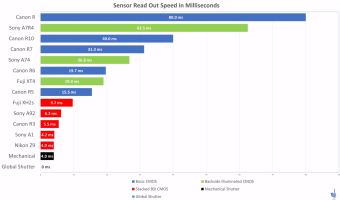Hello,
I read an article with a graph showing Canon R is the worst mirorrless in sensor read speed when using EFCS shutter (possible because it was Canon 1st mirrorless cam).
With EFCS (Silent LV shooting - Mode 1) we don't have the risk of rolling shutter on water moving, like waterfalls, rivers, lakes, etc.? Anyone has enough experience to tell us?
After years I just found many of my landscape photos are blurry because of shutter stock of Canon R mechanical shutter!! Sick :x!
Thanks!
SV
I read an article with a graph showing Canon R is the worst mirorrless in sensor read speed when using EFCS shutter (possible because it was Canon 1st mirrorless cam).
With EFCS (Silent LV shooting - Mode 1) we don't have the risk of rolling shutter on water moving, like waterfalls, rivers, lakes, etc.? Anyone has enough experience to tell us?
After years I just found many of my landscape photos are blurry because of shutter stock of Canon R mechanical shutter!! Sick :x!
Thanks!
SV

